John Miller, Now We’re Big Potatoes, 1992, mixed media, 66 1/4 x 19 3/4 x 15 3/4 inches. Courtesy of the artist and Metro Pictures
Almost everything in New York used to be something else. Well, not the Empire State Building. That was made famous in two movies, King Kong in 1933 and Andy Warhol’s Empire in 1964. Fay Wray and a giant ape were the stars of the first film; the building itself was Warhol’s star. In New York, art has always left traces behind, but like everything else in the city, those traces vanish a little more with every passing day, until they are completely erased. Take Soho, my neighborhood since 1985. Once the heart of the New York art world, it was home to a community of artists and performers who had studios in previously vacant lofts; it held the greatest concentration of galleries and alternative venues, including the Kitchen and Anthology Film Archives (both long since relocated); and it even boasted its own newspaper, the Soho Weekly News, which ran from ’73 to ’82. If today there are only a few galleries here, most prominently Team and Deitch Projects, you do pass an artist now and again. Alex Katz and his wife, Ada, are still on West Broadway, and when you spot her on a sunny afternoon it’s as if an Alex Katz portrait just walked by. The painter Neil Jenney can be seen on his way to or from Metropolitan Lumber & Hardware on Spring Street, always dressed in his trademark denim overalls, button-down white shirt, and sneakers. He’s an art worker, not a clotheshorse. Cindy Sherman, a master of many faces and costumes, used to be on Mercer Street, Donald Baechler was over on Crosby, and Jon Kessler lived on West Broadway until he fled for Tribeca ten years back. Donald Judd’s former studio and home stands on the corner of Spring and Mercer, a 19th-century cast-iron structure, five stories high, that’s almost a sculpture of his from another time, a testament to a man who loomed large in Soho in the 70s and 80s and was one of its saviors. In 1959, megalomaniacal urban planner Robert Moses had announced plans to build a ten-lane downtown expressway that would have cut straight through Soho, then zoned for manufacturing. But within ten years’ time it became a thriving neighborhood full of artists—drawn by cheap rents in buildings that were slated to be torn down—many of whom fought against and ultimately defeated plans for the project in 1969. Conversely, Moses’s intention to “part” Soho gave birth to the neighborhood, brought it together, and enabled it to remain intact. Although if you stroll along the streets of Soho today, the word “intact” may be imprecise at best, for the galleries have been replaced by high-end retailers like Dolce & Gabbana and Chanel, while shoppers and tourists outnumber artists by the many thousands to one. The heyday of Soho as an art neighborhood spanned from the mid-70s to the mid-90s, when ever-spiraling rents sent galleries packing for desolate west Chelsea, and stores, mostly fashion and design stores, took their place. Walking around the neighborhood, the traces of Soho past have mostly been consigned to memory, but it’s not only a building or a facade that looms before us, it’s the recollection of art and artists and exhibitions. Here, then, a short tour of those cobbled streets from a somewhat hobbled mind.
Videos by VICE
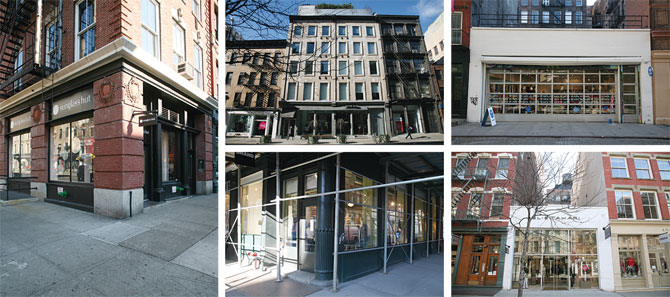
Clockwise from left: Sunglass Hut, DKNY, Adidas, Elie Tahari, Lucky Bran
The place to start is 420 West Broadway, site of Soho’s first and most prominent gallery building, once home to Sonnabend and Leo Castelli. This is where in the early years one came to see the shows of Jasper Johns, Roy Lichtenstein, Bernd and Hilla Becher, and Gilbert & George, and in the 80s encountered works like Jeff Koons’s sculpture Michael Jackson and Bubbles. Today, the ground floor is occupied by Donna Karan’s DKNY store, while the upper floors are enormous luxury lofts. Favorite show: Vito Acconci, Seedbed, 1971. The artist spent six hours a day for two weeks fantasizing and masturbating under a ramp in Sonnabend. One critic at the time recalled loudly stomping up and down the ramp, followed by the artist’s voice: “Oh, step on me, step on me harder.” Second fave: Acconci again, Where Are We Now (Who Are We Anyway?), 1976. For this installation, a long, low table with stools on either side extended across the room and a good six feet out the third-story window. From the street below it appeared to be a suicidal diving board, from which one might be forced to “walk the plank.”
Directly across the street was the Mary Boone Gallery, where the plate-encrusted paintings of Julian Schnabel were famously shown, as were the works of Ross Bleckner, Sherrie Levine, and David Salle. The space is currently occupied by fashion designer Elie Tahari. Memorable moment: On the way in to the gallery one day to see a show of new alchemical paintings by Sigmar Polke, collector Elaine Dannheisser was on the way out. Asked what she thought of the show, she replied in no uncertain terms: “I’m not going to pay a quarter of a million dollars for a painting that’s going to turn black!”
Today, at the corner of West Broadway and Spring Street one can bask in the bounty of Sunglass Hut. In 1974, however, this was the location of Rene Block’s gallery and of his most important presentation, the first by Joseph Beuys in the US, an action/performance titled I Like America and America Likes Me. Until this time, the artist had refused to enter the country while the war in Vietnam was ongoing. But in May of that year he arrived in New York, was met at the airport by an ambulance, wrapped in a felt blanket, and driven to the gallery, where he lived alongside and interacted with a live coyote. Each day 50 bundled copies of the Wall Street Journal were delivered (which were often urinated upon by the coyote). Beuys was armed with only a felt blanket, a cane, and a flashlight. At the end of three days he returned to the airport and flew back to Germany.
Food, an artist-run restaurant that was a collaborative venture initiated by Carol Goodden, Suzanne Harris, Tina Girouard, Rachel Lew, and Gordon Matta-Clark, opened at Prince and Wooster on September 25, 1971. There were guest chefs on Sundays, and according to Goodden, “Gordon’s meals were the most talked about. There was a bone dinner. We served 100 people that night—plates filled with chicken bones, beef bones stuffed with wild rice and mushrooms, frog legs, marrow bones… Richard Peck was in the back scrubbing bones that people had finished eating, and Hisachiki Takahashi (our friendly jeweler) drilled holes through the bones. We strung them on rope and handed the bones back to the customers as necklaces so they could wear their dinners home.”1 The current occupant is Lucky Brand jeans.
1 Gordon Matta-Clark: A Retrospective, Museum of Contemporary Art Chicago, 1985, p. 39.
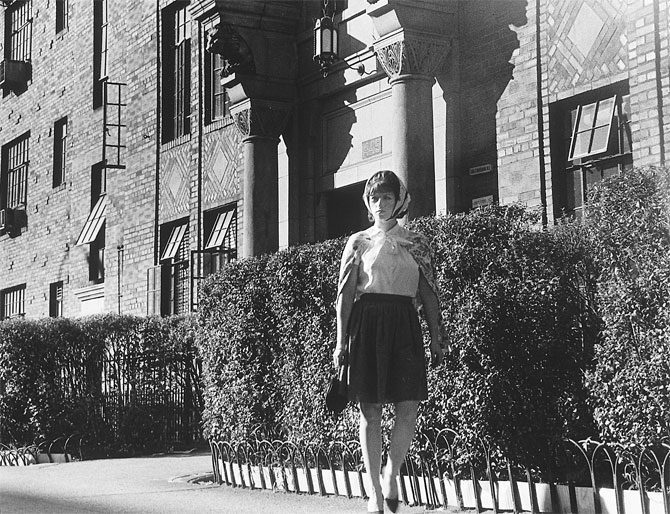
Cindy Sherman, Untitled Film Still (#18), 1978, black-and-white photograph, 8 x 10 inches. Courtesy of the artist and Metro Pictures
Turning the corner, we come upon a former garage on Wooster Street housing an Adidas store that was previously the downtown satellite of Gagosian gallery. Where once one encountered Damian Hirst’s sliced-up cow and Andy Warhol’s “Camouflage” paintings, there are now endless displays of sneakers, including the Porsche, Ambition, Superstar 80s, and Decade Low models, to which you can draw your own art comparisons and conclusions.
A bit farther up the block, near Houston, is the site of Soho’s first commercial space, Paula Cooper Gallery, which opened in 1968. Throughout the 70s it was where one came to see classic Minimal art: Carl Andre, Jo Baer, Donald Judd, and Sol LeWitt. In the mid-80s Robert Gober began to show at the gallery, followed by Cady Noland and Rudolf Stingel in the early 90s. Favorite show: Cady Noland, 1994. One work based on pillory stocks was titled Your Fucking Face, and the artist would from time to time put herself on display, sticking her head, arms, and legs through the holes, to be locked in place, temporarily imprisoned and on view for anyone who came to see the show. Stocks, historically, were a means not only to punish an offender but to publicly humiliate the person. In other works from this period, Noland presented images of politicians who had disgraced themselves or been brought down (most prominently Richard Nixon) or became so much grist for the media mill (from stalker Charles Manson to the stalked Jackie O). Inserting her own immobilized body within this sculpture, Noland voluntarily became part of a pathetic spectacle: a debased figure of fun. The show also included works based on tire swings, which seen in clear view of the stocks resembled nothing more than a gallows. In the very same room today there are the products of Ligne Roset; furniture, lighting, rugs, and textiles by the French design company whose name “is synonymous with modern luxury” and that invites “consumers to revel in a contemporary, design-forward lifestyle.”
Walking one block over to Greene Street brings us to Moss, the “temple” of contemporary design. Here you’ll find items like the Valentina La Donna e Mobile Vita Privata four-poster bed by designer Giuseppe Canevese for a mere $9,100. Luc Merx’s Fall of the Damned suspension light will set you back considerably more, as much as $48,000 (although Moss’s website lists it as “price on request”). In a previous incarnation, 150 Greene Street had been Metro Pictures, the first New York gallery of Mike Kelley, Cindy Sherman, and Martin Kippenberger. One of my all-time favorite works shown at Metro: a banner by Mike Kelley that proclaimed, “Pants Shitter & Proud P.S. Jerk-Off Too (And I Wear Glasses),” not forgetting the veritable orgy of sewn-together stuffed animals and dolls in More Love Hours Than Can Ever Be Repaid. Try explaining that on the Privata four-poster bed.
A few doors down, the second and much larger Leo Castelli Gallery at 142 Greene is now the Paul Smith flagship store. For men, the Willoughby Mid Fit Two Piece Suit lists for $1,130, but Multi Stripe Boxers are only $60. If you, like so many of us, spend much of the day lazing around the house, think of it as inexpensive lounge wear. For women, the stakes are always higher in every sense of the word. The Tailored Jacquard Wool Crombie can be had for less than $800, while the classic Black Pleated Dress runs near $2,000. These prices are, of course, pocket change compared with the sticker shock one routinely encounters in galleries. In the fall of 1988, for example, when Richard Serra showed his steel sculpture Reading Cones at Castelli on Greene Street, it was being offered for $200,000. The show was to mark one of the most tragic moments in the gallery’s history when, during deinstallation, the 16-ton piece collapsed, taking down a pair of cast-iron columns and pinning two workers, one of whom was seriously injured. Best show: Bruce Nauman’s 1984 installation, Room With My Soul Left Out, Room That Does Not Care.
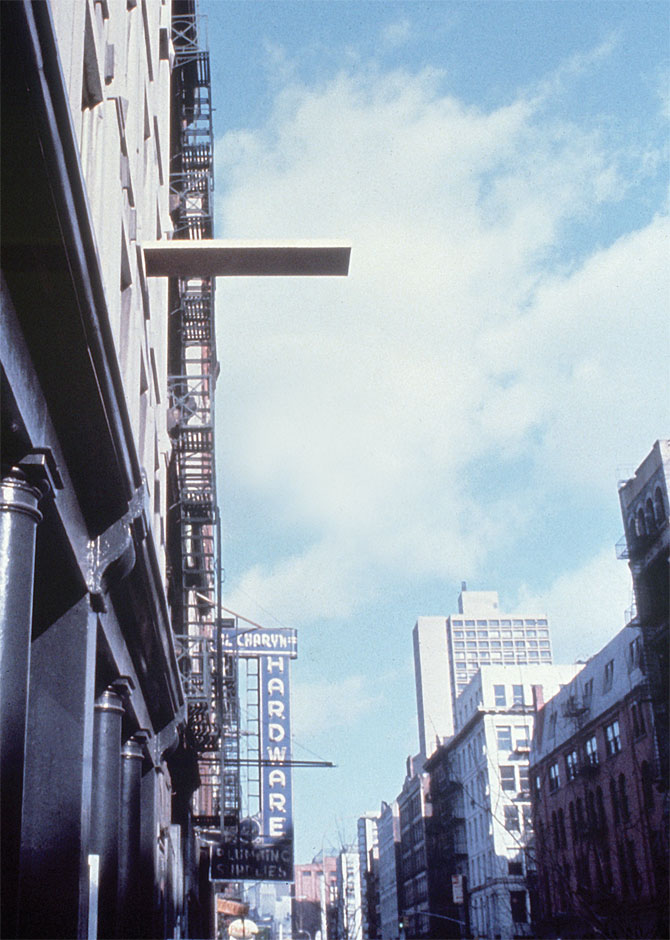
Vito Acconci, Where We Are Now (Who Are We Anyway?), 1976, wooden table and stools, painted wall, four-channel audio, 10′ x 54′ x 32′ (variable). Installation view, Sonnabend Gallery, New York. Courtesy of Sonnabend Gallery
The gallery of Tony Shafrazi was originally over on Mercer Street, in what is now Marc Jacobs. That the man who recklessly in his youth had spray-painted the slogan “Kill Lies All” across Picasso’s Guernica would end up famous for bringing graffiti to the attention of collectors seems oddly inevitable. Shafrazi’s big star, Keith Haring, had started out underground, in the subways with his barking dogs, spaceships, and signature “Radiant Baby.” By the mid-80s his work hung on elegant uptown walls and in European museums. The rise of street artists at the time, especially those whose works began to command five and six figures, was an irritant to starving artists who didn’t take it seriously. A particularly nasty moment on Mercer Street: an opening for Haring. At one point the artist was outside on the sidewalk in front of the gallery hanging out with friends when, suddenly, someone smeared him with a sticky, tarlike substance and attempted to shower him with feathers.
Most people who shop or can only afford to window-shop at the Prada store on the corner of Broadway and Prince are unaware that for ten years, from its opening in 1992, it was the Guggenheim Soho. With more than 25,000 square feet of exhibition space, the museum’s southern outpost was meant to take advantage of its proximity to the galleries in the neighborhood and, situated on downtown’s main commercial thoroughfare, the hordes of shoppers and tourists who descend on lower Broadway year-round. Despite exhibitions with older masters such as Paul Klee alongside modern masters like Robert Rauschenberg, you had to enter the museum through the gift shop. A sore point for most art-world insiders, the implicit message being: Buy a souvenir first and then see the show or, even worse, just visit the gift shop and, not having paid for admission and entered the museum proper, simply be on your merry way. By 2002, strapped with financial problems, the writing was on the wall for the expansionist Guggenheim, and the museum’s installation of Warhol’s final series of paintings, “The Last Supper,” provided ironic counterpoint to its closure.
A short block west on Prince was Annina Nosei, the gallery of Barbara Kruger and Jean-Michel Basquiat, who, legend has it, had been kept down in the basement by the wily dealer, painting day after day. This was also the gallery that, nervously and rightly so, gave me my first job in New York back in ’84. Where I once sat, with barely a clue about who I was or what I was meant to do, at a small desk by the front door, the frocks of Miu Miu hang from the racks. Memorable moment: At an opening one night, a polite young man asked Nosei whether he might use the restroom. Without a second’s thought she replied, “We don’t have one, and it’s not working.”
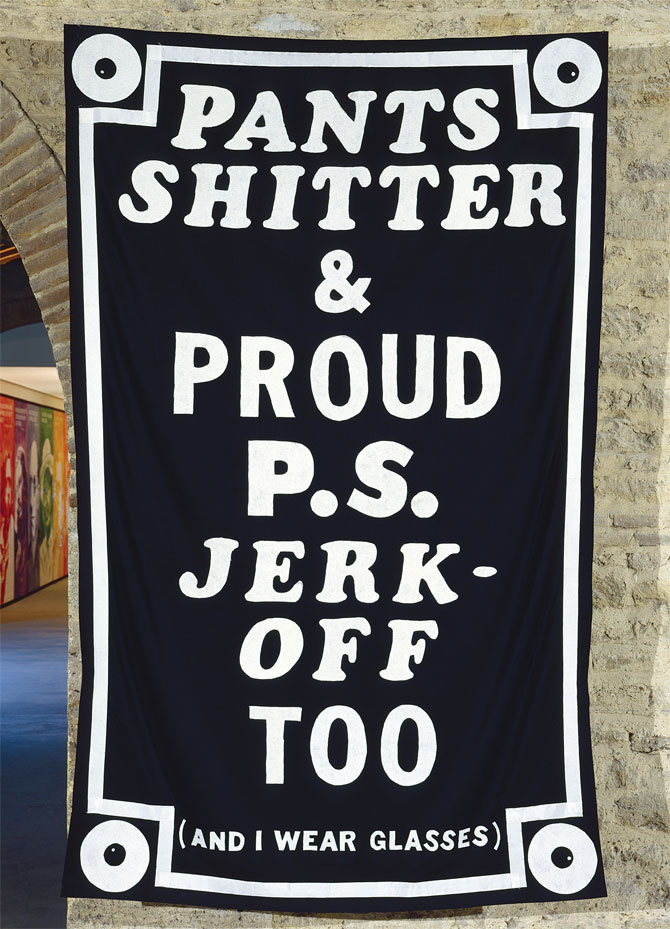
Mike Kelley, Three Point Program/Four Eyes, 1987, glued felt, 94 x 59.5 inches. Courtesy of Kelley Studio
The former Soho location of the Barbara Gladstone Gallery is now space.NK apothecary from London. On offer are detox products, including ones to de-bloat, de-stress, and re-energize, as well as tanning bronzer, aromatherapy, Rescue Mask skin care, Crushed Jewel gel liner, Gothic Lolita Rococo nail polish, and muscle-relief bath soak. The latter may have come in handy for Matthew Barney, after completing the performance for his 1991 debut at Gladstone, for which he spent the night before mountaineering in the gallery, naked and with Vaseline-lubed ice-climbing screws in his anus, scaling the walls and ceiling as if attempting the savage peaks of K2.
Finally, all the way down on Greene Street at number 43 we find ourselves at Bisazza, purveyors of fine Italian glass and metallic mosaic tiles. Their products aren’t within everyone’s reach. They grace Cher’s swimming pool, and prices go as high as $580 per square foot for glass with hand-applied white-gold leaf. The former occupant was David Zwirner, who mounted shows here with Rachel Khedoori, Jason Rhoades, Franz West, and, appropriately enough, just a few blocks south of the original site of Food, Gordon Matta-Clark. Some days in Soho, you can almost feel the old bones still rattle.
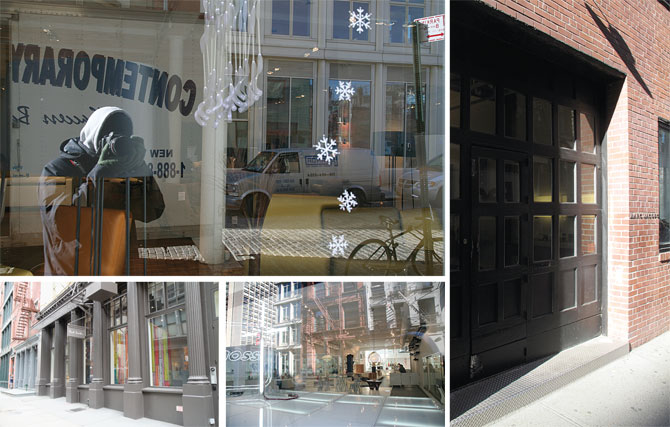
Clockwise from top left: Ligne Roset, Marc Jacobs, Moss, Paul Smith
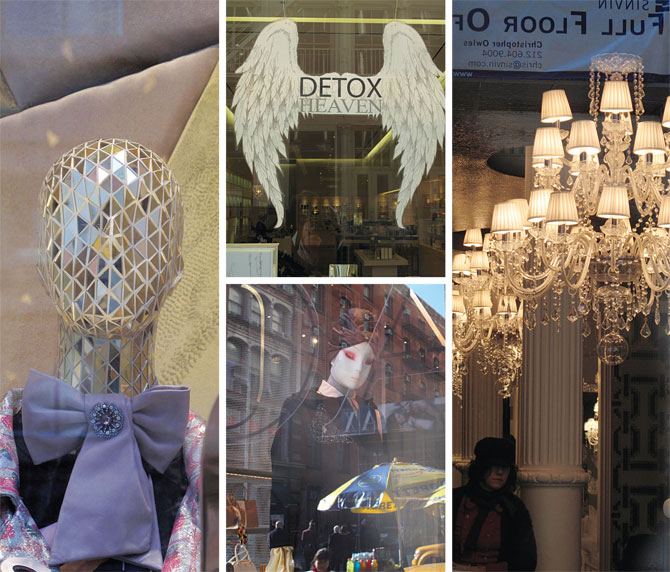
Clockwise from left: Miu Miu, space.NK apothecary, Bisazza, Prada
Matthew Barney, Repressia (Decline), 1991. Installation view, Barbara Gladstone Gallery, New York. Courtesy of Gladstone Gallery


